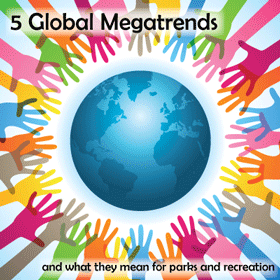I recently read an article about the insurance industry’s assessment of “five global certainties that will impact insurance, business, and the world.” With a title like that, you just have to open it and read it, right? I mean, it’s only prudent to get smart about global certainties that will impact the world.
 So what are these earth-shaking ‘megatrends’ that will impact business, the world, and of course, the insurance industry?
So what are these earth-shaking ‘megatrends’ that will impact business, the world, and of course, the insurance industry?
Well, they are nothing we haven’t heard or seen before, and in fact several of them are in the headlines every day, but it is instructive to consider how the insurance industry, which is all about the business of assessing risk, considers the impact of these big trends.
Author Laura Mazzuca Toops reported on an analysis that has been underway for the last three years by PriceWaterhouseCooper, and which was presented recently to the IICF Women’s Insurance Forum.
Five Global Megatrends
- Technological breakthroughs
- Climate change and resource scarcity
- Demographic shifts
- Accelerating urbanization
- Shift in global economic power
The panelists, Kelley Buchanan and Tim Ryan of PwC, note that global trends are large scale changes already underway and while they may appear modest now, are estimated to have a profound effect on life as we know it in coming years. The analysis cites some startling statistics about these megatrends. For example, regarding technological breakthroughs, they note that there were only 0.08 connected devices per person in 2003, but by 2020 there will be over 50 billion connected devices, more than six per person!
In terms of resource scarcity and climate change, the world will need to produce 40 percent more water, 50 percent more energy and 35 percent more food just to keep up with population growth. The impacts of global warming in sea-level rise, extreme weather and temperature increases will stretch natural resources even more.
It is widely predicted that the U.S. will become a minority-majority nation by 2043, but perhaps more striking is that a few years after that, we will have the highest percentages of people over 70 and under 5, something that has never occurred before.
Another megatrend that has received widespread attention is the increasing urbanization of, not just our nation, but the world. Back in 2008, half the population lived in urban areas, but by 2050, nearly 75 percent will live in urban areas. The trend will be especially prevalent in the United States with up to 80 percent of the U.S. population predicted to live in urban areas.
So what does all this talk about megatrends have to do with parks and recreation? Plenty.
NRPA Connect is already lit up on a daily basis with questions and discussion about how technology is affecting how people enjoy their parks and participate in recreation programs and events. More and more agencies are going online to reach patrons and purchase registration systems, perform automatic monitoring of buildings and the environment, monitor public safety and employ technology to complete missions. Parks and recreation is being dramatically affected by leaps in technology. In addition, kids will clearly turn to tech to connect to nature and the outdoors. Will it be a barrier or a gateway to richer experiences?
Our nation’s greatest environmental challenges will be tested by climate change and global warming. Already climate change is starting to have major effects on coastal cities and park and recreation agencies in low-lying elevations, and it is not just flooding and storm surge that are affecting agencies nation-wide. Extreme weather events in the heartland, scorching drought in the South and West, and concerns about protecting fresh water everywhere are making people ask what can be done? Parks will be in the forefront of public education and coastal protection strategies.
When you consider the implications of the rapid urbanization of America, parks and recreation will have an increasingly important role to play in shaping successful cities. This is where the people will be, this is where the funding will be, this is where the action is.
Parks and recreation will be involved through economic development, urban revitalization strategies, innovation districts and walkable, dense, urban places, (WalkUPS, as they are called by hip urbanists). Combined with huge demographic shifts, majority-minority populations and the rise of metropolitan areas, urban parks will play one of the most important roles in shaping cities. NRPA along with the American Planning Association recently released a white paper that discusses how parks influence economic development, health outcomes and green infrastructure in urban locations.
These five global megatrends are like tidal currents—you don’t sense the tide is inexorably coming in, but all of a sudden, you can be floating free and far from shore.
Parks and recreation needs to be on the cutting edge of making these trends work for the people we serve.
What has your response to these trends been so far? What role do you think parks and recreation play in these five trends? Tell us in the comments below or tweet us @NRPA_News.
Barbara Tulipane, CAE is NRPA's President and CEO.

